英语常用修辞格的翻译
- 格式:ppt
- 大小:161.00 KB
- 文档页数:31

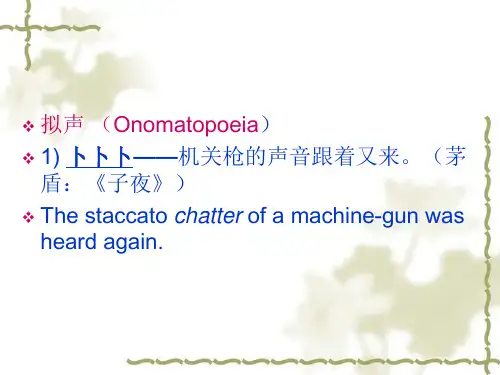
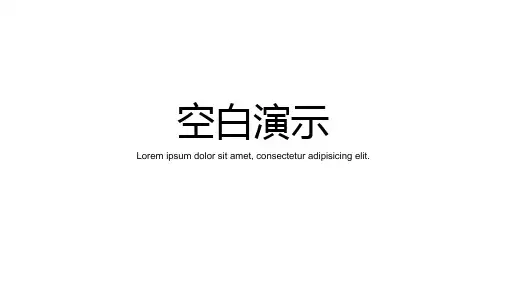
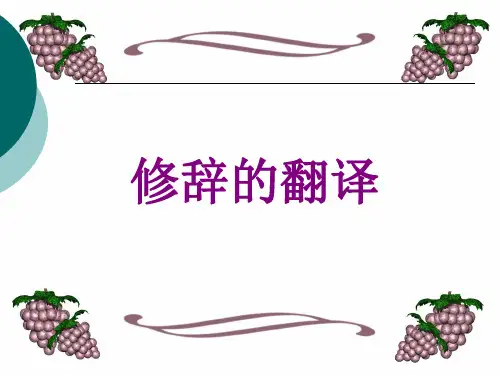
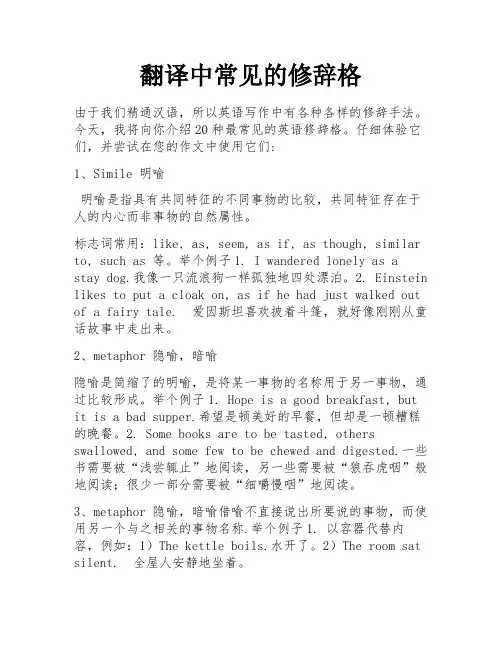
翻译中常见的修辞格由于我们精通汉语,所以英语写作中有各种各样的修辞手法。
今天,我将向你介绍20种最常见的英语修辞格。
仔细体验它们,并尝试在您的作文中使用它们:1、Simile 明喻明喻是指具有共同特征的不同事物的比较,共同特征存在于人的内心而非事物的自然属性。
标志词常用:like, as, seem, as if, as though, similar to, such as 等。
举个例子1. I wandered lonely as astay dog.我像一只流浪狗一样孤独地四处漂泊。
2. Einstein likes to put a cloak on, as if he had just walked out of a fairy tale. 爱因斯坦喜欢披着斗篷,就好像刚刚从童话故事中走出来。
2、metaphor 隐喻,暗喻隐喻是简缩了的明喻,是将某一事物的名称用于另一事物,通过比较形成。
举个例子1. Hope is a good breakfast, but it is a bad supper.希望是顿美好的早餐,但却是一顿糟糕的晚餐。
2. Some books are to be tasted, others swallowed, and some few to be chewed and digested.一些书需要被“浅尝辄止”地阅读,另一些需要被“狼吞虎咽”般地阅读;很少一部分需要被“细嚼慢咽”地阅读。
3、metaphor 隐喻,暗喻借喻不直接说出所要说的事物,而使用另一个与之相关的事物名称.举个例子1. 以容器代替内容,例如:1)The kettle boils.水开了。
2)The room sat silent. 全屋人安静地坐着。
2. 以资料、工具代替事物的名称,例如:Lend me your ears, please. 请听我说。
3. 以代替作品,例如:a plete Shakespeare 莎士比亚全集4. 以具体事物代替抽象概念,例如:I had the muscle, and they made money out of it. 我有力气,他们就用我的力气赚钱。
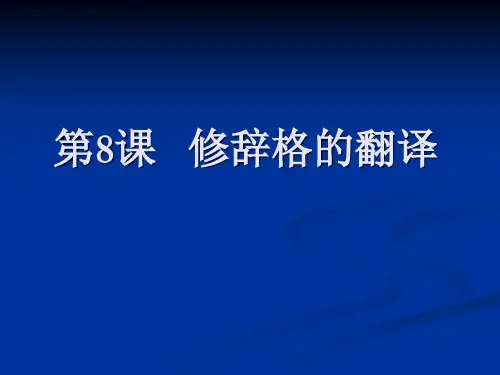
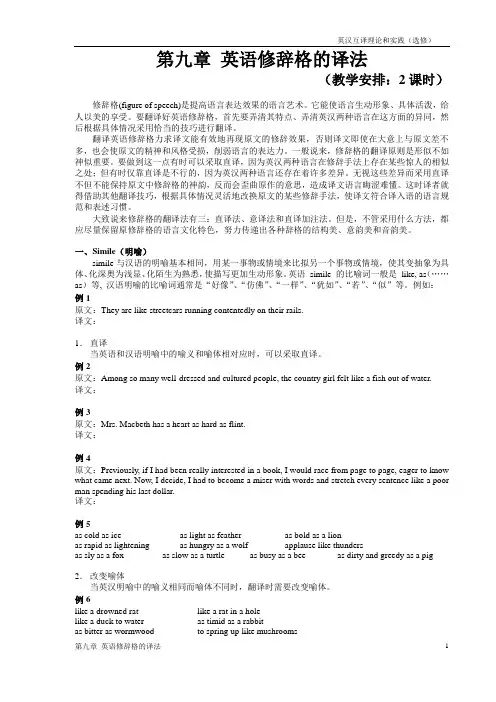
第九章英语修辞格的译法(教学安排:2课时)修辞格(figure of speech)是提高语言表达效果的语言艺术。
它能使语言生动形象、具体活泼,给人以美的享受。
要翻译好英语修辞格,首先要弄清其特点、弄清英汉两种语言在这方面的异同,然后根据具体情况采用恰当的技巧进行翻译。
翻译英语修辞格力求译文能有效地再现原文的修辞效果,否则译文即使在大意上与原文差不多,也会使原文的精神和风格受损,削弱语言的表达力。
一般说来,修辞格的翻译原则是形似不如神似重要。
要做到这一点有时可以采取直译,因为英汉两种语言在修辞手法上存在某些惊人的相似之处;但有时仅靠直译是不行的,因为英汉两种语言还存在着许多差异。
无视这些差异而采用直译不但不能保持原文中修辞格的神韵,反而会歪曲原作的意思,造成译文语言晦涩难懂。
这时译者就得借助其他翻译技巧,根据具体情况灵活地改换原文的某些修辞手法,使译文符合译入语的语言规范和表述习惯。
大致说来修辞格的翻译法有三:直译法、意译法和直译加注法。
但是,不管采用什么方法,都应尽量保留原修辞格的语言文化特色,努力传递出各种辞格的结构美、意韵美和音韵美。
一、Simile(明喻)simile与汉语的明喻基本相同,用某一事物或情境来比拟另一个事物或情境,使其变抽象为具体、化深奥为浅显、化陌生为熟悉,使描写更加生动形象。
英语simile 的比喻词一般是like, as(……as)等, 汉语明喻的比喻词通常是“好像”、“仿佛”、“一样”、“犹如”、“若”、“似”等。
例如:例1原文:They are like streetcars running contentedly on their rails.译文:1.直译当英语和汉语明喻中的喻义和喻体相对应时,可以采取直译。
例2原文:Among so many well-dressed and cultured people, the country girl felt like a fish out of water.译文:例3原文:Mrs. Macbeth has a heart as hard as flint.译文:例4原文:Previously, if I had been really interested in a book, I would race from page to page, eager to know what came next. Now, I decide, I had to become a miser with words and stretch every sentence like a poor man spending his last dollar.译文:例5as cold as ice as light as feather as bold as a lionas rapid as lightening as hungry as a wolf applause like thundersas sly as a fox as slow as a turtle as busy as a bee as dirty and greedy as a pig 2.改变喻体当英汉明喻中的喻义相同而喻体不同时,翻译时需要改变喻体。
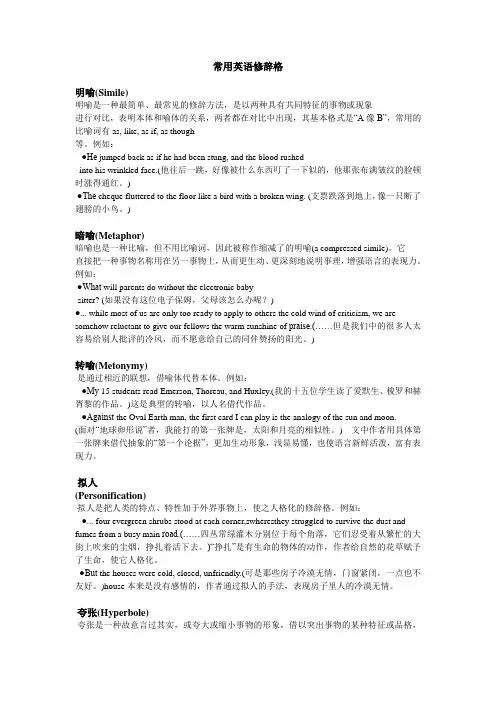
常用英语修辞格明喻(Simile)明喻是一种最简单、最常见的修辞方法,是以两种具有共同特征的事物或现象进行对比,表明本体和喻体的关系,两者都在对比中出现,其基本格式是“A像B”,常用的比喻词有as, like, as if, as though等。
例如:●He jumped back as if he had been stung, and the blood rushedinto his wrinkled face.(他往后一跳,好像被什么东西叮了一下似的,他那张布满皱纹的脸顿时涨得通红。
)●The cheque fluttered to the floor like a bird with a broken wing. (支票跌落到地上,像一只断了翅膀的小鸟。
)暗喻(Metaphor)暗喻也是一种比喻,但不用比喻词,因此被称作缩减了的明喻(a compressed simile)。
它直接把一种事物名称用在另一事物上,从而更生动、更深刻地说明事理,增强语言的表现力。
例如:●What will parents do without the electronic baby-sitter? (如果没有这位电子保姆,父母该怎么办呢?)●... while most of us are only too ready to apply to others the cold wind of criticism, we are somehow reluctant to give our fellows the warm sunshine of praise.(……但是我们中的很多人太容易给别人批评的冷风,而不愿意给自己的同伴赞扬的阳光。
)转喻(Metonymy)是通过相近的联想,借喻体代替本体。
例如:●My 15 students read Emerson, Thoreau, and Huxley.(我的十五位学生读了爱默生、梭罗和赫胥黎的作品。
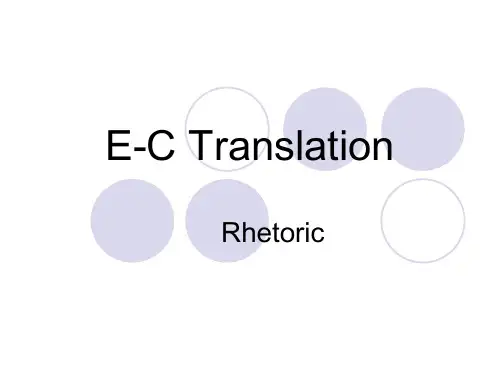
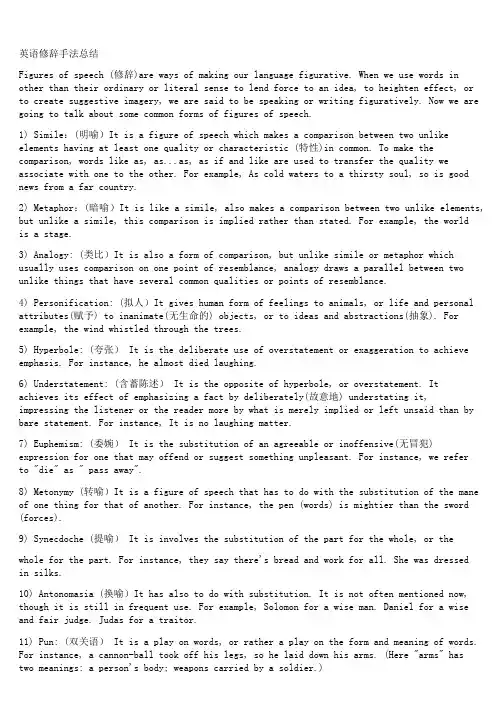
英语修辞手法总结Figures of speech (修辞)are ways of making our language figurative. When we use words in other than their ordinary or literal sense to lend force to an idea, to heighten effect, orto create suggestive imagery, we are said to be speaking or writing figuratively. Now we are going to talk about some common forms of figures of speech.1) Simile:(明喻)It is a figure of speech which makes a comparison between two unlike elements having at least one quality or characteristic (特性)in common. To make the comparison, words like as, as...as, as if and like are used to transfer the quality we associate with one to the other. For example, As cold waters to a thirsty soul, so is good news from a far country.2) Metaphor:(暗喻)It is like a simile, also makes a comparison between two unlike elements, but unlike a simile, this comparison is implied rather than stated. For example, the worldis a stage.3) Analogy: (类比)It is also a form of comparison, but unlike simile or metaphor which usually uses comparison on one point of resemblance, analogy draws a parallel between two unlike things that have several common qualities or points of resemblance.4) Personification: (拟人)It gives human form of feelings to animals, or life and personal attributes(赋予) to inanimate(无生命的) objects, or to ideas and abstractions(抽象). For example, the wind whistled through the trees.5) Hyperbole: (夸张) It is the deliberate use of overstatement or exaggeration to achieve emphasis. For instance, he almost died laughing.6) Understatement: (含蓄陈述) It is the opposite of hyperbole, or overstatement. Itachieves its effect of emphasizing a fact by deliberately(故意地) understating it,impressing the listener or the reader more by what is merely implied or left unsaid than by bare statement. For instance, It is no laughing matter.7) Euphemism: (委婉) It is the substitution of an agreeable or inoffensive(无冒犯) expression for one that may offend or suggest something unpleasant. For instance, we referto "die" as " pass away".8) Metonymy (转喻)It is a figure of speech that has to do with the substitution of the mane of one thing for that of another. For instance, the pen (words) is mightier than the sword (forces).9) Synecdoche (提喻) It is involves the substitution of the part for the whole, or thewhole for the part. For instance, they say there's bread and work for all. She was dressedin silks.10) Antonomasia (换喻)It has also to do with substitution. It is not often mentioned now, though it is still in frequent use. For example, Solomon for a wise man. Daniel for a wise and fair judge. Judas for a traitor.11) Pun: (双关语) It is a play on words, or rather a play on the form and meaning of words. For instance, a cannon-ball took off his legs, so he laid down his arms. (Here "arms" hastwo meanings: a person's body; weapons carried by a soldier.)12) Syllepsis: (一语双叙) It has two connotations.In the first case, it is a figure by which a word, or a particular form or inflection of a word, refers to two or more words in the same sentence, while properly applying to or agreeing with only on of them in grammar or syntax(句法). For example, He addressed you and me, and desired us to follow him. (Here us is used to refer to you and me.)In the second case, it a word may refer to two or more words in the same sentence. For example, while he was fighting , and losing limb and mind, and dying, others stayed behind to pursue education and career. (Here to losing one's limbs in literal; to lose one's mindis figurative, and means to go mad.)13) Zeugma: (轭式搭配) It is a single word which is made to modify or to govern two or more words in the same sentence, wither properly applying in sense to only one of them, or applying to them in different senses. For example, The sun shall not burn you by day, nor the moon by night. (Here noon is not strong enough to burn)14) Irony: (反语) It is a figure of speech that achieves emphasis by saying the opposite of what is meant, the intended meaning of the words being the opposite of their usual sense. For instance, we are lucky, what you said makes me feel real good.15) Innuendo: (暗讽) It is a mild form of irony, hinting in a rather roundabout (曲折)way at something disparaging(不一致) or uncomplimentary(不赞美) to the person or subject mentioned. For example, the weatherman said it would be worm. He must take his readings in a bathroom.16) Sarcasm: (讽刺) It Sarcasm is a strong form of irony. It attacks in a taunting and bitter manner, and its aim is to disparage, ridicule and wound the feelings of the subject attacked. For example, laws are like cobwebs, which may catch small flies, but let wasps break through.17) Paradox: (似非而是的隽语) It is a figure of speech consisting of a statement or proposition which on the face of it seems self-contradictory, absurd or contrary to established fact or practice, but which on further thinking and study may prove to be true, well-founded, and even to contain a succinct point. For example more haste, less speed.18) Oxymoron: (矛盾修饰) It is a compressed paradox, formed by the conjoining(结合) of two contrasting, contradictory or incongruous(不协调) terms as in bitter-sweet memories, orderly chaos(混乱) and proud humility(侮辱).19) Antithesis: (对照) It is the deliberate arrangement of contrasting words or ideas in balanced structural forms to achieve emphasis. For example, speech is silver; silence is golden.20) Epigram: (警句) It states a simple truth pithily(有利地) and pungently(强烈地). It is usually terse and arouses interest and surprise by its deep insight into certain aspects of human behavior or feeling. For instance, Few, save the poor, feel for the poor.21) Climax: (渐进) It is derived from the Greek word for "ladder" and implies the progression of thought at a uniform or almost uniform rate of significance or intensity,like the steps of a ladder ascending evenly. For example, I came, I saw, I conquered.22) Anti-climax or bathos: (突降)It is the opposite of Climax. It involves stating one's thoughts in a descending order of significance or intensity, from strong to weak, from weighty to light or frivolous. For instance, But thousands die, without or this or that, die, and endow(赋予) a college, or a cat.23) Apostrophe: (顿呼) In this figure of speech, a thing, place, idea or person (dead or absent) is addressed as if present, listening and understanding what is being said. For instance, England! awake! awake! awake!24) Transferred Epithet: (转类形容词) It is a figure of speech where an epithet (anadjective or descriptive phrase) is transferred from the noun it should rightly modify(修饰) to another to which it does not really apply or belong. For instance, I spent sleeplessnights on my project.25) Alliteration: (头韵) It has to do with the sound rather than the sense of words for effect. It is a device that repeats the same sound at frequent intervals(间隔) and since the sound repeated is usually the initial consonant sound, it is also called "front rhyme". For instance, the fair breeze blew, the white foam flew, the furrow followed free.26) Onomatopoeia: (拟声) It is a device that uses words which imitate the sounds made by an object (animate or inanimate), or which are associated with or suggestive(提示的) of some action or movementExplanation version1一、什么是修辞格修辞格(figures of speech)是提高语言表达效果的语言艺术。
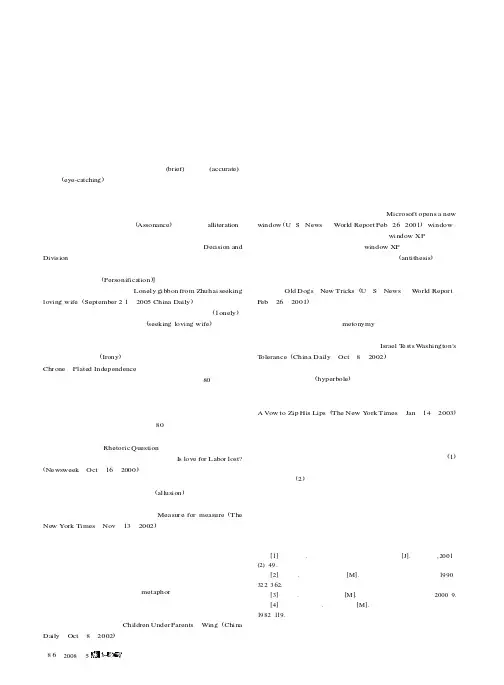
56英语新闻标题的十大修辞格及其翻译人们的生活离不开新闻,而标题则是新闻的“文眼”。
因此,新闻标题除了在选词上做到新颖、抢眼之外,“通常还采用各种修辞手段来增强语言的简练性、形象性和趣味性”。
英语新闻要吸引住更多的广大中国读者的目光,新闻标题中的修辞法的翻译方法就很值得探讨。
简洁(brief)、准确(accurate)、抢眼(eye-catching )是新闻标题翻译的宗旨,力求在汉译时兼顾三个方面:准确理解标题、领悟其妙处、适当照顾译文特点、增强可读性;重视读者的接受能力。
以下对英语新闻标题的十大修辞格的特点及其相关翻译法进行初步探讨。
押韵:押韵包括元韵(Assonance )和头韵(alliteration )等。
元韵“是指连续几个词重复同一个或近似的元音,求取悦耳效果的辞格”,而头韵读来则很有节奏感,如“Decision and Division ”就是利用头韵来加快句子的节奏,让读者读起来朗朗上口。
拟人:拟人(Personification )]使句子更加生动、形象,让读者产生一种亲切感。
如:Lonely gibbon from Zhuhai seeking loving wife (September 21,2005China Daily )在此标题中,长臂猿被赋予了人的情感:孤独(1onely );以及人的行为方式:寻找爱妻(seeking loving wife )。
读者读后不禁莞而一笑,自觉甚是有趣。
译文:《珠海一孤独长臂猿苦寻爱妻》反语:反语(Irony )旨在通过发笑达到讽刺的目的。
如:Chr one —Plated Independence这则新闻标题嘲弄的是一个每年只能生产出80万吨铬的小国扬言要完全独立。
用直译加注解的方法来翻译,保留了原语的幽默与讽刺意味,同时,译文读者还能得到与原文读者大致相同的感受。
译文:《铬板式的独立—年产80万吨铬的小国扬言要完全独立》设问:设问(Rhetoric Question )就是“用疑问句的方式增强语言表达效果的一种修辞方式。
英语常用语义修辞格的翻译英、汉两种语言在语义方面都有大量的修辞方式。
这两种语言中经常运用形象性手段来加强语言效果,从而达到修辞目的。
而这种比喻性手段在两种语言中的表达方式上与形象性的比喻上,有的相同,有的不尽相同。
有的形象性用法能为一种语言的读者有所了解、接受,而对另一种语言的读者则显得陌生或不能接受。
因此,在翻译英语语义修辞格时,不仅要注意形式上的对应,更应注意符合汉语的表达习惯。
本文拟讨论英语常用的语义修辞格的翻译。
一、明喻(simile)在翻译英语的明喻时,一般采用直译法,将其译成汉语的明喻。
但由于英汉两个民族的历史发展、生活环境、风俗习惯各不相同,思维方式和美学观念也有所差异,有的英语明喻和汉语明喻的比喻形象不尽相同。
因此,有时也用意译法、变通法和注释法。
如:He was like a cock who thought the sun hadrisen for him to crow. 他这人就像一只骄傲的公鸡,以为太阳升起是为了它的啼叫。
( simile →明喻。
直译法)Tom was as sober as a judge. 他十分清醒。
(simile →非修辞格。
意译法)He is as cunning as a dead pig. 他像狐狸一样狡猾。
(simile →明喻。
但不是“像死猪一样狡猾”。
变通法)Falstaff : I am as poor as Job , my lord , but not sopatient . 福斯塔夫: 我是像约伯(注) 一样穷的,大人,可是却没有他那样的好耐性。
(注:约伯(Job)《圣经》中的人物, 以忍耐贫穷而著称的圣徒。
)(simile →明喻。
但译文意义不清楚,故加了注释。
注释法)二、隐喻(metaphor)英语隐喻的翻译,一般采用修辞格转换法或直译法,将其译成汉语的明喻或隐喻。
但由于英汉两种文化的差异,有时需要转换表达或修辞方式、或改变喻体以符合汉语的习惯。